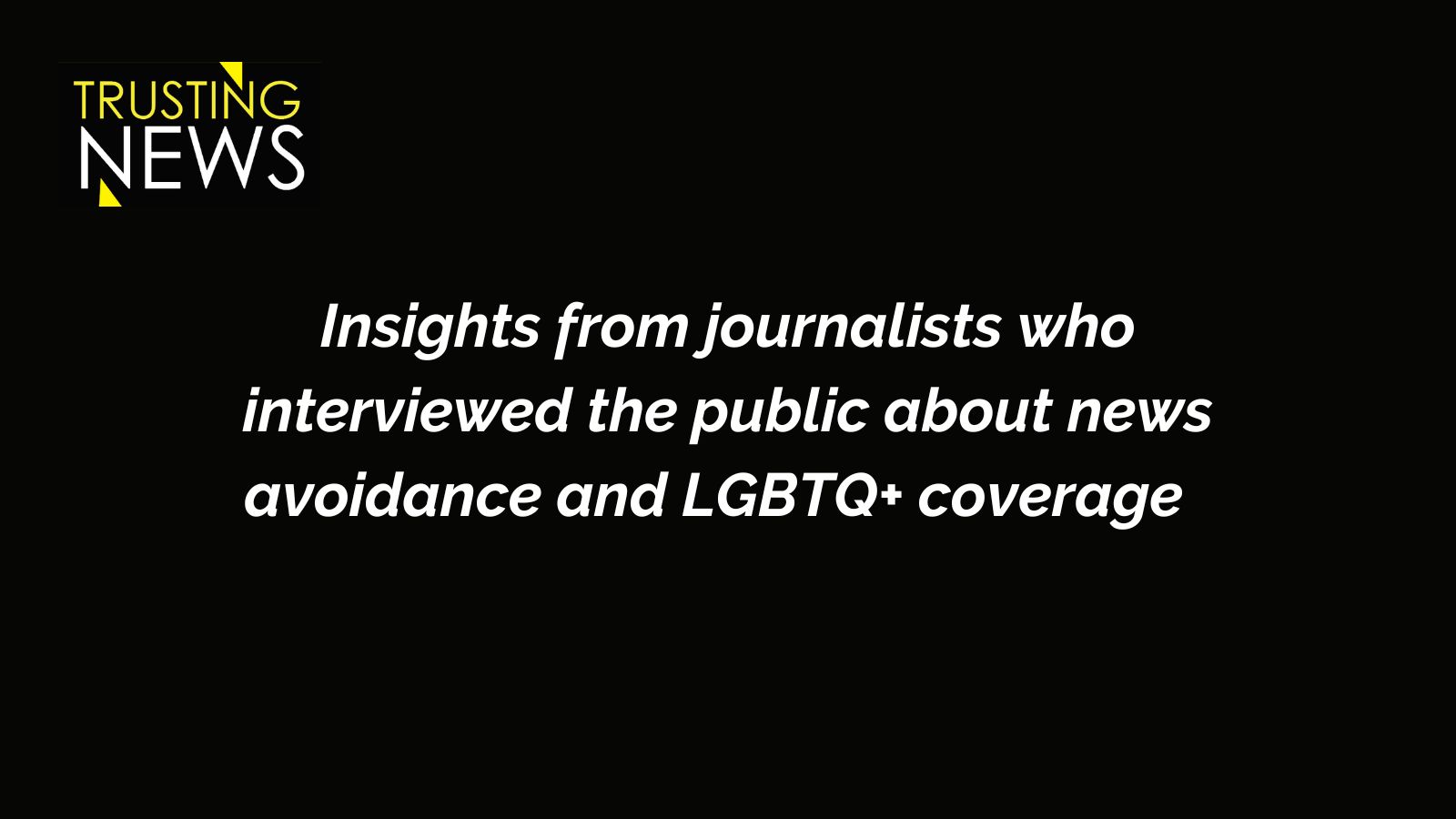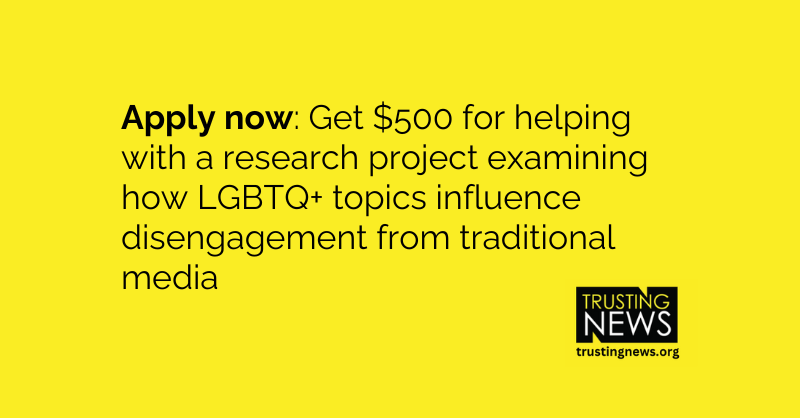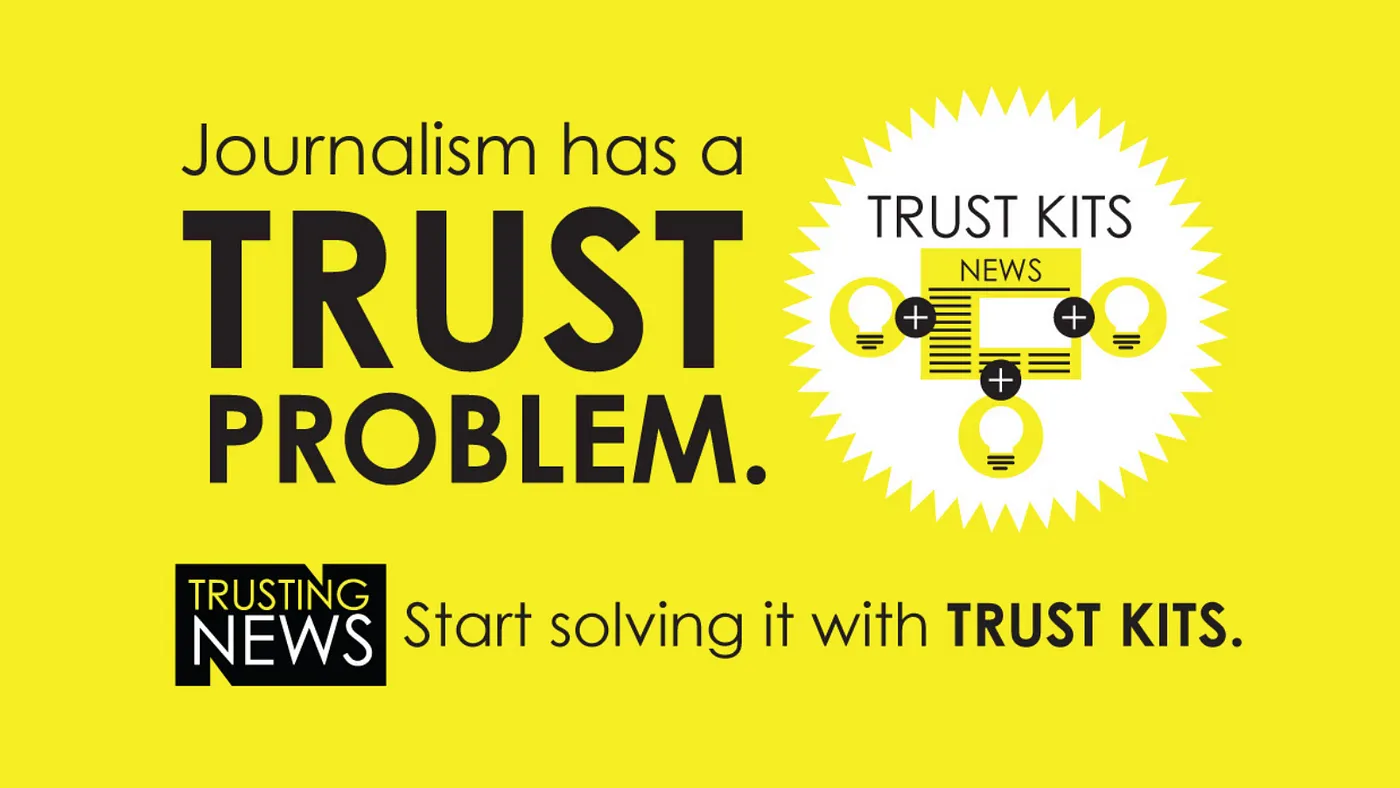
For this research project, seven journalists spent the last two months interviewing people about news avoidance and LGBTQ+ issues.
Reflections from journalists: What we learned talking about news avoidance and LGBTQ+ coverage
This post was written by Trusting News research partner Patrick R. Johnson. Johnson, Ph.D., MJE, is an Assistant Professor of Journalism at Marquette University. His work focuses primarily on three areas: news literacy, journalism education and practice, and issues of sex and sexuality, with an emphasis on LGBTQ+ individuals and communities.
Editor’s note: We anonymized the reflections from journalists in the project, except in the cases where they granted us permission to use their names.
What does it mean when people avoid the news, not because they don’t care, but because engaging with it feels unsafe or exhausting? And what happens when the topic of LGBTQ+ identity becomes the trigger for that avoidance?
Those were the guiding questions behind a recent listening project, which explored how LGBTQ+ topics shape news avoidance, in collaboration with Trusting News and me. Seven journalists from across the United States each interviewed eight people in their communities about their relationships with news, asking what makes them trust, or disengage from, journalism.
While some interviewees identified as LGBTQ+, many did not. Some expressed resistance to LGBTQ+ visibility in the media, offering a broader view into how these topics operate as fault lines in public trust.
The goal wasn’t to study LGBTQ+ audiences alone, but to understand how LGBTQ+ issues intersect with patterns of avoidance, harm, and mistrust. What emerged were complex reflections, not just on the content of coverage, but on its tone, repetition, sourcing, emotional impact and representational gaps.
We recently convened a final reflection call with five of the participating journalists. More will come in the fall, when we’ve had time to review all the interviews with community members. We will also share then more information about the project’s methodology and findings. For now, we share five early insights and reflections from that conversation.
First, a big thanks to the journalists involved. This work is never easy, especially this project where we asked journalists to dive into challenging topics. We’re so grateful for their deep investment in this work. We can’t do this type of research without them.
News avoidance is a boundary, not disengagement
For some in this project, avoiding the news wasn’t about disinterest; it was about protecting their mental and emotional well-being. One journalist noted, “That was kind of the really common thread … avoiding news as a form of self-preservation.” Another shared that “overwhelm was the number one emotion that kept being mentioned,” especially about LGBTQ+ issues. People were not tuning out because they didn’t value information, but because engaging with journalism often left them feeling anxious, defeated, or even unsafe.
Avoidance in this context should be understood as a rational act of boundary-setting in response to harm, not a failure of civic responsibility. If news consistently retraumatizes, retraumatization becomes the headline. As one journalist put it, people “curated their news” or “filtered what they could handle,” particularly when it came to anti-LGBTQ+ legislation, hateful rhetoric, or dehumanizing commentary.
Newsroom takeaway: Adopt a trauma-informed lens throughout your coverage. This means recognizing that news, especially around LGBTQ+ issues, can be emotionally overwhelming or retraumatizing for audiences. When people say they’ve stopped reading because “it hurts,” that’s a signal to adjust how we report.
Resources:
- The Dart Center’s Styleguide for trauma-informed journalism.
- Lisa Krantz, Ph.D., at the University of Montana, is a leading thinker in this area and a valuable resource.
- Trusting News often talks about the power of journalists extending empathy to their audiences. You can start simple, by acknowledging to your audience that the news is often overwhelming, depressing and hard to read. If it’s been a heavy news week, encourage them to take breaks if needed. You can also use it as an opportunity to point your audience to more solutions or joy-based stories.
Over-reliance on the same sources erodes trust
Several community members noted a troubling pattern in LGBTQ+ coverage: the same organizations and spokespeople being quoted again and again. While these sources may be credible, this repetition can flatten the community and limit nuance. “They noticed that the local news station would go to the same organizations over and over,” one journalist reported. Another summarized: “It’s problematic when you have one person as a voice that is charged with representing the community.” This is something we’ve seen time and again in listening sessions: journalists tend to focus on the loudest person in the room in their reporting, which can cause harm to the communities they aim to serve.
This over-reliance can make coverage feel disconnected from everyday LGBTQ+ life. It also places an unfair burden on a small number of individuals to speak for an entire, diverse group. The journalists noticed that community members felt that only certain (oftentimes economically successful or prominently placed) community organizations were the go-to sources for stories. This left many smaller (often more intersectional and/or grassroots) organizations without a voice in the news about their communities. And, as the next insight shows, this extends to how individuals are seen and feel seen or heard.
Newsroom takeaway: Diversify your sourcing networks. Go beyond advocacy organizations and seek out queer and trans individuals from varied racial, class, religious, generational, and geographic backgrounds. Trust is built when people feel seen in their complexity, not just represented through a familiar proxy.
Resources:
- Trusting News’ Listening Trust Kit is a good place to start if you want to get to know your community better and diversify your sourcing. Through listening, you can not only better understand people’s news needs, but also tap into places and people your community wants to hear from.
- Journalists had similar reflections from a past listening project, where they heard from people with low trust in news that they wanted to hear more nuanced coverage and not to just hear from the loudest or same people all the time.
Trust improves when journalists reveal their process
Another powerful sentiment was that people trusted journalism more when they understood how stories were made. As journalist Carrie Cochran put it, “People talked about trusting journalists when they knew more about their process and knew more about them.” This didn’t mean reporters had to overshare their personal lives, but explaining sourcing, editorial choices, or even personal stakes went a long way. While one journalist shared that the process was important to the community members, others nodded in agreement when this insight was brought up.
Cochran also recounted how a community member’s view changed after watching a documentary where the reporter was interviewed about their methods: “It totally changed their perception of the work.” Transparency built trust, not because it proved objectivity, but because it demonstrated intention.
Newsroom takeaway: Build reflexivity into your reporting. Include “how we reported this” sidebars, introduce yourself in sourcing calls, or show your audience why you made the choices you did. People are more willing to trust journalism when they can see its scaffolding.
Resources:
- Trusting News’ Transparency Trust Kit walks you through what parts of your reporting process to get transparent about and how to connect that to your daily coverage.
Representation matters, and trans storytelling demands special care
Journalists share that they heard that LGBTQ+ people are often represented in news only during moments of harm: when a bill is proposed, when a protest erupts, when a tragedy occurs. This limited framing sends an implicit message: that queer, and particularly trans, people are only newsworthy when under threat. One journalist summarized a community member’s experience this way: “They don’t see themselves reflected in the news unless something has gone wrong.”
This kind of representational absence is not just a gap; it’s a distortion. LGBTQ+ individuals are not passive recipients of harm; they are educators, artists, parents, faith leaders, and students. When journalism fails to reflect the fullness of queer life, it contributes to the very disengagement it seeks to address.
One participant commented on the repetitive nature of coverage: “It always feels like either we’re being attacked or used to prove a point; there’s nothing in between.” That emotional toll builds up over time, and it shows up as news avoidance. Beyond this, representation also included how some community members felt seen, which in turn pushed them to avoid. This included one journalist sharing how a community member said he “never even seen…a regularly masculine kind of gay person in the news.” Instead, that community member shared that he felt every gay person he saw was flamboyant, which didn’t accurately represent him. This stereotypical flamboyant gay man is a common form of LGBTQ+ representation throughout history, something LGBTQ+ historian Larry P. Gross would say is news’s inability to break free from proscribed limitations and embrace the complex reality of LGBTQ+ individuals’ identities.
But within that broader pattern, stories about trans people stood out as especially harmful. This wasn’t only about being left out; it was about being misrepresented, caricatured, or politicized in ways that feel dehumanizing. One journalist shared a painful reflection from their interview: “[The news] were really emphasizing treating trans people like a monolith, treating trans people like monsters or groomers, and just failing to understand or accept the basic humanity of trans people.” Another noted that several community members had “stopped reading the news altogether because of how trans issues were covered.” The concern associated with coverage of trans lives emerged in every journalist’s experience, and each noted that the elevated coverage regarding gender-affirming care (which was just in the news with a major SCOTUS decision) and transgender athletes.
Critiques weren’t just about inaccuracies. The journalists shared that they were about assumptions and values. Community members consistently raised concerns about who gets to tell trans stories, how those stories are framed, and whether journalists truly understand the stakes. Some flagged coverage of youth sports as an especially egregious example of misplaced news judgment. As one participant put it: “A trans student playing a game is not a story. These kids don’t deserve that.” The harm wasn’t just in how the story was written; it was in deciding to write it at all. The problem wasn’t a factual error. The problem was that the framing treated their existence as a controversial issue, rather than as a lived experience.
The harm wasn’t always inaccuracy; it was tone, framing, sourcing, and silence. Some journalists recounted interviewees who said that even when news outlets were trying to be “fair,” they framed trans rights as a cultural debate, rather than a lived reality. Others noted that trans people were often quoted only reactively (e.g., when legislation was passed or a public figure said something harmful) but rarely invited to shape the narrative from the beginning. There were concerns not only about the content, but also about who is allowed to tell trans stories and under what assumptions.
This insight asks something different of journalism. It’s not just about inclusion; it’s about dignity, complexity, and agency. It’s about moving beyond a checkbox approach to LGBTQ+ coverage and into a practice of listening, relationship-building, and ethical reflexivity. It’s about recognizing that how we report is what we report.
Although most community members focused on LGBTQ+ representation as either lacking or misrepresented, there were subtle indications that not all disengagement stemmed from underrepresentation. Some of the journalists shared that a few individuals seemed to express discomfort or fatigue with the increased visibility of LGBTQ+ people in the news, not because of how they were portrayed, but because they were there at all. While these comments were not always explicit, they reflect how ideological or identity-based discomfort can influence news avoidance in ways that are more effective than articulated, suggesting a disengagement rooted less in critique than in rejection. This sentiment led us to this project, as we had encountered it in a similar project we completed in 2022.
Newsroom takeaway: Representation cannot be reactive or extractive. Audit your LGBTQ+ coverage — who is featured, when, and why? Build relationships with queer and trans communities outside of moments of crisis. And when reporting on trans issues, treat care as an editorial principle. Avoid false balance. Reject dehumanizing frames. Center trans voices. Involve trans journalists and editors whenever possible. Ask not only whether your story is accurate, but whether it’s just.
Resources:
- Ask sources what they are afraid you might get wrong
- Rethink some word choices to be more hearable
- Research: Rectifying Harm Through Care-Based Practices: How Journalists Might Tend to Disengaged Communities
Queer joy is missing, and people notice
One of the more striking observations came from the absence of something: joy. Journalists reported that several interviewees expressed a deep desire to see stories of LGBTQ+ celebration, love, creativity, and connection. “There was a lack of joy in the queer experience,” one journalist recalled. Another mentioned that “several [people said] queer joy is missing in the storytelling.”
This feedback isn’t simply a request for happier content; it’s a critique of narrative imbalance. When news media only spotlight queer people in moments of pain, it contributes to an incomplete and potentially damaging story about who LGBTQ+ people are. Joy is not a luxury, but a form of truth. And its absence has consequences for trust, belonging, and representation.
Newsroom takeaway: Make space for queer joy. Include stories of achievement, celebration, art, friendship, family, and humor. Normalize the full emotional spectrum of LGBTQ+ life, not just its tragedies.
Resources:
- Outright Vermont: Queer Joy As Empowerment
- Yes! Solutions Journalism: The Art of Queer Joy
- The Queer Joy Project
- Trish Bendix: Opinion | Why queer joy is worth documenting, too
Full research insights coming this fall
We look forward to sahring more information in the fall once we’d finished analyzing all the interviews with community members. The best way to be alerted when this new research publishes is to subscribe to our weekly Trust Tips newsletter, and to follow Trusting News on LinkedIn or BlueSky.
Questions? Concerns? Please feel free to reach out to me directly or to the Trusting News team at info@trustingnews.org.
At Trusting News, we learn how people decide what news to trust and turn that knowledge into actionable strategies for journalists. We train and empower journalists to take responsibility for demonstrating credibility and actively earning trust through transparency and engagement. Learn more about our work, vision and team. Subscribe to our Trust Tips newsletter. Follow us on Twitter, BlueSky and LinkedIn.


